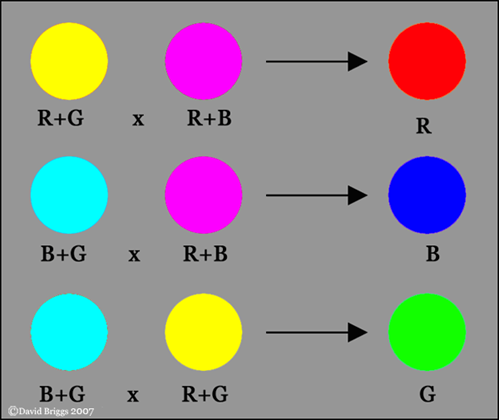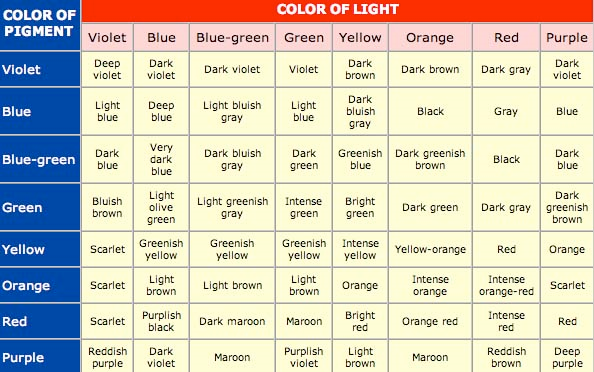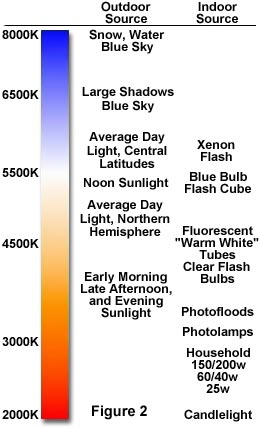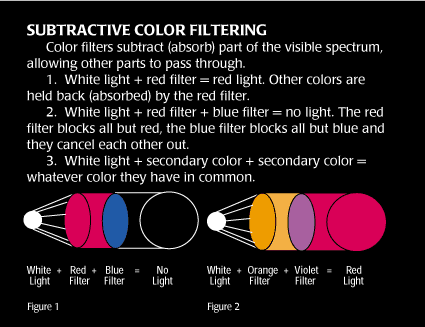|
Lighting in the theatre an be considered an art as well as a science. A  lighting designer has succeeded when the audience can walk out of a theatre and comment on how good the show was with the emphasis on the actors and set etc. If they mention the lighting then it has not been subtle enough and the lighting designer to a certain degree has failed. lighting designer has succeeded when the audience can walk out of a theatre and comment on how good the show was with the emphasis on the actors and set etc. If they mention the lighting then it has not been subtle enough and the lighting designer to a certain degree has failed.
But first to the science. coloured light behaves differently to coloured pigments and dyes. there are two colour systems:- additive and subtractive also known as RGB or red green and blue and CMYK cyan, magenta, yellow and black. colour systems:- additive and subtractive also known as RGB or red green and blue and CMYK cyan, magenta, yellow and black.
When red, green and blue light is mixed together you get white light. the filters absorb all colours except the desired one so a red filter absorbs all colours except red which it allows through. A blue filter absorbs all colours except blue which it allows through. If a red and blue filters are fitted to the same light fixture then very little or no light will get through as the red filter only allows red light out. as blue filters absorb all colours except blue the red light is absorbed so no light escapes.
Additive is adding different sources of coloured light (i.e. LED fixtures are additive because you are adding different coloured LED's together to make one colour), and subtractive is subtracting colours from white light using gels or graduated filters such as those found in moving head fixtures. For a fuller explanation see below
Additive and Subtractive Colour Mixing
The world is full of colours. Some researchers report that humans can distinguish about 16 million different colours. But what's more interesting is that most of the colours we see around us and all the colours we see on a TV or computer monitor can be created from just three different coloured lights. How are all the colours made from just three different colours? Simply by combining the light in different ratios. That's it. Adjusting the brightness of three colours in different ways creates all the colours you see in this graphic:
Additive Colours
Coloured lights are mixed using additive colour properties. Light colours are combining two or more additive colours together which creates a lighter colour that is closer to white. Examples of additive colour sources include computers and televisions.
The additive primary colours are red, green and blue (RGB). Combining one of these additive primary colours with equal amounts of another one results in the additive secondary colours of cyan, magenta and yellow. Combining all three additive primary colours in equal amounts will produce the colour white. Remember combing additive colours creates lighter colours, so adding all three primary colours results in a colour so "light" it's actually seen as white. Although that may seem strange, if you think of the absence of all light equalling black, it begins to make sense that adding different colours creates white.
Additive Colours Combined in Equal Parts
Blue + Green=Cyan
Red + Blue=Magenta
Green + Red=Yellow
Red + Green + Blue=White
By changing the brightness of each of the three primary colours by varying degrees, you can make a wide range of colours.
Additive Colours Combined in Unequal Parts
1 Green + 2 Red=Orange
1 Red + 2 Green=Lime
1 Green + 1 Blue + 4 Red =Brown
Computer Monitors and Televisions
When White Isn't White
Look closely at a white spot on your computer monitor using a strong magnifying glass or eye loop. You should be able to see that the white dot isn't really white, but rather is a combination of red, green and blue dots all located very, very close to one another.
Computer monitors and televisions are an application of additive colour. These devices use a mosaic of red, green and blue dots. Our eyes do not distinguish the dots. Rather, the dots stimulate the colour receptors of our retina (called cones) by adding or blending the light together creating a composite colour.
Subtractive Colour Mixing
Before TVs and computer monitors, printers and publishers wondered if they could print colour pictures using just three colours of ink. Yes, it is possible, but you have to work in reverse of the process of mixing light colours! We see light colours by the process of emission from the source. We see pigment colours by the process of reflection (light reflected off an object). The colours which are not reflected are absorbed (subtracted).
The subtractive primary colours are cyan, magenta and yellow (CMY). These are the three colours used in printer ink cartridges.
When the source of colour is pigment or dye, the result of combining colours is different from when the source of colour is light. Subtractive colour mixing occurs when light is reflected off a surface or is filtered through a translucent object. For example, a red pigment or filter only appears red because it absorbs (subtracts) all of the light that is not red and only reflects or allows the red light. A green pigment only reflects green light and a green filter only passes green light.
Let's say, for example, we want to absorb the colour blue. From the additive colour chart above (Additive Colours Combined in Equal Parts), we know we get a yellow light when we combine the two non-blue light primaries, green and red. Therefore, wherever we paint yellow on the paper, we absorb (subtract) blue. Combining the other primary light colours results in the following table showing the subtractive primaries:
Subtractive Colours Cyan, Magenta and Yellow
Absorbs Creates
Blue + Green Red Cyan
Red + Blue Green Magenta
Green + Red Blue Yellow
So, when working with colour pigments, you'll end up using Cyan, Magenta and Yellow as the primary colours.
But how do we print something that's red?
In order to print something that is red, we need to absorb both blue and green. (Remember, we're working in reverse.) To absorb the blue, we'll print yellow. To absorb green, we'll print magenta. So, by combining both yellow and magenta pigments, we're left with red!
If we wanted to print the colour yellow, we would need to combine the red and green pigments. This yellow pigment reflects both red and green, and absorbs blue. Likewise, combining green and blue creates cyan, and absorbs red. Combining red and blue creates magenta, and absorbs green.
Blackness of Black
As you can see, by working with subtractive pigments, combining all three yields black. In practice, however, the combination of all three does not yield nearly as true of a black colour as printing with black directly, so most colour printing is done with four ink colours, cyan, magenta, yellow and black, or CMYK for short. A "K" is used instead of a "B" to avoid confusion with blue. In the case of ink jet printers, it's also much cheaper to print with black ink.
To be ideal primary colours for subtractive mixing, the filters would instead need to completely transmit a combination of two of the additive primaries at a time, and completely absorb the third. There are just three such possible combinations (R+G, R+B, G+B), and each pair of these combinations has one and only one of the additive primaries in common. As we saw in the last section, these combinations are seen as yellow, magenta and cyan respectively, and are each the additive complementary of the remaining additive primary (Figure 5.4). Yellow (R+G) and magenta (R+B), for example, having red in common, at full intensity mix subtractively to make red. Changing the intensity of one or other of the components produces a continuous range of intermediate hues between yellow and magenta (Figure 5.5). No colour is shared by all three primaries, and so subtractive mixture of the three at full intensity produces pure black.

 

|